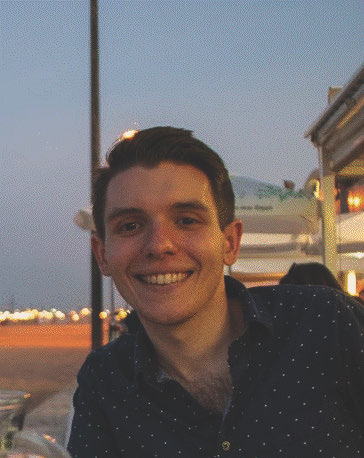
I am currently the Morawetz Postdoctoral Fellow at the Courant Institute of Mathematical Sciences associated with New York University (NYU). My work broadly pursues using mathematics to understand how biological systems (cells and smaller) overcome and utilize randomness.
Randomness in biology
If you picture a cell, an image that pops up for many people is the one they saw in their grade-school biology textbook: a nice, spherical balloon with a highly organized, compartmentalized interior. While this is certainly reflective of the rich variety and complexity of machines within a cell, the reality is that physics and chemistry tell us that the interior is far more dynamic and random than these stationary cartoons portray. Molecules inside a cell, such as proteins, are small enough that a significant driver of their movement is Brownian motion, a stochastic process. These particles are randomly bouncing around in a crowded space and also undergoing chemical reactions, which are also often modeled as stochastic events. We are left with a bit of a paradox: how can cells both be this richly organized, functional machine built from random, tumultuous components? Using mathematics to understand the role of stochasticity in cell biology has been a major thrust of mathematical biology over the span of the last several decades [1] and a central theme of my work.
One story of randomness in cells from my research is trying to understand how cells send and receive signals. The rough idea is that on the surface of a cell, there are receptors (think satellite dishes) that wait around for a diffusing signal molecule to hit them. The important thing to emphasize here is that the random motion of the diffusing signal molecule is not just an annoyance for the cell, but an essential ingredient for this mechanism to work. Theory and modeling to understand how this could be a viable signaling mechanism have a rich history but my favorite result is the classical work of Berg & Purcell [2]. By writing down a PDE with mixed absorbing (on receptors) and reflecting (elsewhere) boundary conditions, the authors calculate the flux to the receptors from diffusing molecules. Surprisingly, this flux does not depend on the net surface area as one might guess, but rather the net perimeter of the receptors. This gives us an important clue about how these function. Imagine a water drain in a rainstorm. Although some water is flowing into the drain directly from the sky, the majority of it is entering from the sides, meaning the flux through the drain is probably better modeled by the perimeter rather than the area of the drain. This classical work tells us that receptors behave similarly.
Figure 1. A diffusing (interior) molecule searching for a diffusing target receptor.
As far as our contribution, in collaboration with Sean Lawley at the University of Utah, we asked: what happens if you include the biologically observed feature that the receptors themselves diffuse? Here, you’re not changing the size of the target, you’re just allowing it to move randomly as well. Interesting results about diffusing searchers looking for diffusing targets have been found in other geometric scenarios such as 1D [3] but we wanted to model this closer to the geometry of the cell. We therefore modified the classical Berg-Purcell model to allow for the receptor locations to undergo Brownian motion on the sphere, resulting in a deterministic PDE with boundary conditions enforced at stochastic locations. Through singular perturbation theory, we found in [4] that this extra motion indeed increases the flux for external signal molecules and in [5] we found a similar result for interior particles. Here, we see a design principle of cells: random motion helps speed up this signaling mechanism and facilitates its function. This is just one of many questions you could ask about this receptor mechanism. More recently, we took an interpretation of thinking of it as an engineered channel to ask information-theoretic questions about different receptor configurations [6]. This is also just one of endless examples of how randomness influences how cells function and I hope to continue exploring these in the future.
My trajectory here
Something I think worth mentioning about my academic trajectory is that I am a first-generation college student. From undergrad to even now as a postdoc, this has provided a lot of unknowns that were difficult to navigate, but ultimately the compassionate support of mentors has allowed me to make it here. SIAM as an organization, and especially the those that regularly attend the SIAM Conference on Dynamical Systems have provided a really strong community of people eager to provide mentorship and help. I am passionate about paying this forward and wanted to put a note that if any individuals (first-gen or otherwise) are feeling these same struggles, I am happy to talk about any of these things or anything in this article. Feel free to contact me any time or say hello if we cross paths!
References
[1] P. C. Bressloff, Stochastic Processes in Cell Biology, vol. 41. Springer International Publishing, 2014.
[2] H. C. Berg and E. M. Purcell, “Physics of chemoreception,” Biophysical Journal, vol. 20, no. 2, pp. 193–219, 1977.
[3] J. C. Tzou, S. Xie, and T. Kolokolnikov, “First-passage times, mobile traps, and Hopf bifurcations,” Phys. Rev. E - Stat. Nonlinear, Soft Matter Phys., vol. 90, no. 6, pp. 1–10, 2014.
[4] S. D. Lawley and C. E. Miles, “Diffusive Search for Diffusing Targets with Fluctuating Diffusivity and Gating,” Journal of Nonlinear Science, vol. 29, no. 6, pp. 2955–2985, Dec. 2019.
[5] S. D. Lawley and C. E. Miles, “How Receptor Surface Diffusion and Cell Rotation Increase Association Rates,” SIAM Journal on Applied Mathematics, vol. 79, no. 3, pp. 1124–1146, Jan. 2019.
[6] S. D. Lawley, A. E. Lindsay, and C. E. Miles, “Receptor Organization Determines the Limits of Single-Cell Source Location Detection,” Physical Review Letters, vol. 125, no. 1, p. 18102, 2020.